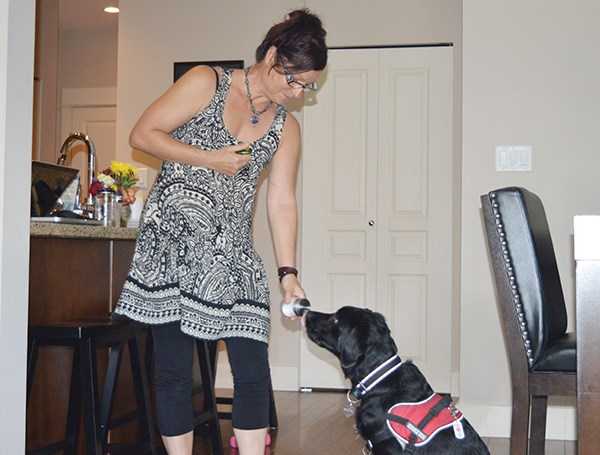As a Type 1 diabetic, Wanda Groetelaars is thankful her dog can be on alert if her blood sugar drops too low.
The black lab, with a heightened sense of smell, is being trained to pick up on her blood sugar levels with saliva.
Groetelaars has lived in Squamish for 20 years, but is in the process of moving to a remote property in Horsefly in the Cariboo, an area without cell service.
There, these health challenges become all the more serious, as help may not be readily available, and if her blood sugar drops too low she faces the risk of a stroke or coma.
To cope, she has been working with her four-legged friend, Sugar Bear, to become a service dog and learn how to alert her.
She took a course in Seattle with noted trainer Mary McKnight and, more recently, she found out about Karen Russell, a trainer in the Lower Mainland.
“It was the first time I’ve ever been excited about being a diabetic,” Groetelaars says. “She’s a huge resource.”
There is a long wait for service dogs from the national foundation for dog guides. On the other hand, it can be prohibitively expensive to buy a trained dog privately.
The alternative is to learn how to train a dog, which is what Groetelaars has been doing of late with Sugar Bear.
“I get them on the right track, and they do a lot of the training themselves,” Russell says about the work she does with dogs. “It creates such a strong bond.”
Groetelaars tried training her other dog, a French bulldog, but the particular breed does not have the olfactory senses to reliably warn Groetelaars, especially if her blood sugar drops to extremely low levels while asleep. In contrast, Sugar Bear is well suited to the task.
“This dog is a nose with other things attached,” Groetelaars says.
Sugar Bear trained to recognize the smell when blood sugar drops to a certain level at which time the dog alerts his owner. To be certified, the canine has to pass tests such as alerting the person or fetching a juice, actions that could be required to protect Groetelaars’ health.
Dogs can even be trained to sound a bell if they are in a crate while the owner is driving.
During training, Sugar Bear gets a food reward, though part of the process is making sure there are no false warnings. Often, service dogs can pick up a scent before monitors can detect a drop.
Sometimes there is a little waiting involved during the training to make sure the animal has picked up the right scent.
Sugar Bear also has to be the kind of dog that is not dissuaded if the diabetic thrashes out, as can sometimes happen.
“Every diabetic is different in how they react,” Groetelaars says.
Even though she has a new home, Groetelaars wants the Squamish community to know about this kind of service. She also wants to help educate the public to realize that service dogs do more than simply help the visually impaired, even if it might not look like the person is in need of the animal.
Finally, she also hopes that diabetes advocates will devote more resources to getting people matched with dogs to help them lead a normal life.
For more information about training, Russell can be contacted at [email protected].
For general information, go to www.dogguides.com/diabetic.html.
(This article has been updated.)



